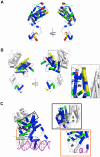Low-resolution molecular models reveal the oligomeric state of the PPAR and the conformational organization of its domains in solution
- PMID: 22363753
- PMCID: PMC3283691
- DOI: 10.1371/journal.pone.0031852
Low-resolution molecular models reveal the oligomeric state of the PPAR and the conformational organization of its domains in solution
Abstract
The peroxisome proliferator-activated receptors (PPARs) regulate genes involved in lipid and carbohydrate metabolism, and are targets of drugs approved for human use. Whereas the crystallographic structure of the complex of full length PPARγ and RXRα is known, structural alterations induced by heterodimer formation and DNA contacts are not well understood. Herein, we report a small-angle X-ray scattering analysis of the oligomeric state of hPPARγ alone and in the presence of retinoid X receptor (RXR). The results reveal that, in contrast with other studied nuclear receptors, which predominantly form dimers in solution, hPPARγ remains in the monomeric form by itself but forms heterodimers with hRXRα. The low-resolution models of hPPARγ/RXRα complexes predict significant changes in opening angle between heterodimerization partners (LBD) and extended and asymmetric shape of the dimer (LBD-DBD) as compared with X-ray structure of the full-length receptor bound to DNA. These differences between our SAXS models and the high-resolution crystallographic structure might suggest that there are different conformations of functional heterodimer complex in solution. Accordingly, hydrogen/deuterium exchange experiments reveal that the heterodimer binding to DNA promotes more compact and less solvent-accessible conformation of the receptor complex.
Conflict of interest statement
Figures









Similar articles
-
Structure of the intact PPAR-gamma-RXR- nuclear receptor complex on DNA.Nature. 2008 Nov 20;456(7220):350-6. doi: 10.1038/nature07413. Nature. 2008. PMID: 19043829 Free PMC article.
-
Effect of heterodimer partner RXRalpha on PPARgamma activation function-2 helix in solution.Biochem Biophys Res Commun. 2008 Jan 4;365(1):42-6. doi: 10.1016/j.bbrc.2007.10.143. Epub 2007 Oct 31. Biochem Biophys Res Commun. 2008. PMID: 17980149 Free PMC article.
-
Phosphorylation of PPARγ Affects the Collective Motions of the PPARγ-RXRα-DNA Complex.PLoS One. 2015 May 8;10(5):e0123984. doi: 10.1371/journal.pone.0123984. eCollection 2015. PLoS One. 2015. PMID: 25954810 Free PMC article.
-
Structural Biology Inspired Development of a Series of Human Peroxisome Proliferator-Activated Receptor Gamma (PPARγ) Ligands: From Agonist to Antagonist.Int J Mol Sci. 2023 Feb 15;24(4):3940. doi: 10.3390/ijms24043940. Int J Mol Sci. 2023. PMID: 36835351 Free PMC article. Review.
-
Structural characterization of proteins and complexes using small-angle X-ray solution scattering.J Struct Biol. 2010 Oct;172(1):128-41. doi: 10.1016/j.jsb.2010.06.012. Epub 2010 Jun 15. J Struct Biol. 2010. PMID: 20558299 Review.
Cited by
-
Nuclear receptor full-length architectures: confronting myth and illusion with high resolution.Trends Biochem Sci. 2015 Jan;40(1):16-24. doi: 10.1016/j.tibs.2014.10.011. Epub 2014 Nov 28. Trends Biochem Sci. 2015. PMID: 25435400 Free PMC article.
-
PPARγ lipodystrophy mutants reveal intermolecular interactions required for enhancer activation.Nat Commun. 2022 Nov 19;13(1):7090. doi: 10.1038/s41467-022-34766-9. Nat Commun. 2022. PMID: 36402763 Free PMC article.
-
Integrative structural biology studies of HIV-1 reverse transcriptase binding to a high-affinity DNA aptamer.Curr Res Struct Biol. 2020;2:116-129. doi: 10.1016/j.crstbi.2020.06.002. Epub 2020 Jun 30. Curr Res Struct Biol. 2020. PMID: 33870216 Free PMC article.
-
Visualizing the Architectures and Interactions of Nuclear Receptors.Endocrinology. 2016 Nov;157(11):4212-4221. doi: 10.1210/en.2016-1559. Epub 2016 Oct 5. Endocrinology. 2016. PMID: 27704949 Free PMC article. Review.
-
Quantitative structural assessment of graded receptor agonism.Proc Natl Acad Sci U S A. 2019 Oct 29;116(44):22179-22188. doi: 10.1073/pnas.1909016116. Epub 2019 Oct 14. Proc Natl Acad Sci U S A. 2019. PMID: 31611383 Free PMC article.
References
-
- Michalik L, Auwerx J, Berger J, Chatterjee V, Glass C, et al. International Union of Pharmacology. LXI. Peroxisome proliferator-activated receptors. Pharmacol Rev. 2006;58:726–741. - PubMed
-
- Szanto A, Nagy L. The many faces of PPARgamma: anti-inflammatory by any means? Immunobiology. 2008;213:789–803. - PubMed
-
- Aranda A, Pascual A. Nuclear hormone receptors and gene expression. Physiol Rev. 2001;81:1269–1304. - PubMed
-
- Desvergne B, Wahli W. Peroxisome proliferator-activated receptors: nuclear control of metabolism. Endocr Rev. 1999;20:649–688. - PubMed
Publication types
MeSH terms
Substances
LinkOut - more resources
Full Text Sources

